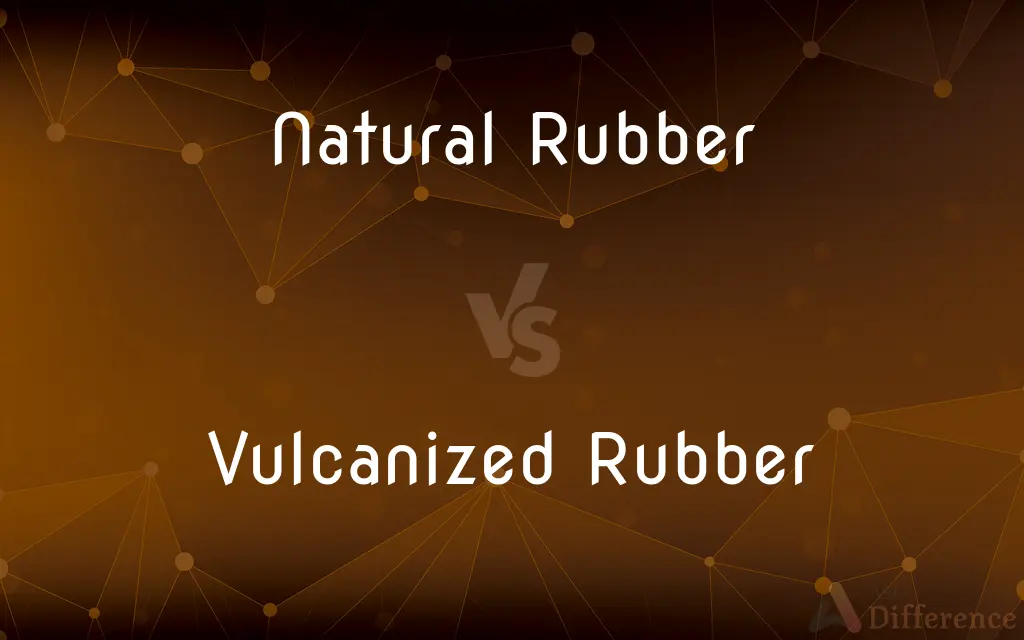Natural Rubber vs. Vulcanized Rubber — What's the Difference?
By Tayyaba Rehman — Published on November 17, 2023
Natural Rubber is a polymer made of isoprene units sourced from latex in certain plants. Vulcanized Rubber is Natural Rubber that's been chemically processed with sulfur to enhance its properties.

Difference Between Natural Rubber and Vulcanized Rubber
Table of Contents
ADVERTISEMENT
Key Differences
Natural Rubber has been in use for thousands of years. Derived from latex found in certain plants and trees, particularly the rubber tree, it's a polymer made primarily of isoprene units. On the other hand, Vulcanized Rubber is a more modern invention. While it starts with Natural Rubber as its base, it undergoes a chemical process involving sulfur to enhance its durability and other properties.
When you think of Natural Rubber, consider its raw properties. It's soft, quite stretchy, and is affected by temperature changes. This makes it versatile for certain applications but not ideal for all. Vulcanized Rubber was developed in response to these limitations. By adding sulfur and applying heat, the rubber undergoes a transformative process, making it tougher, more elastic, and more resistant to wear and tear.
Natural Rubber has its advantages, such as high elasticity and the ability to recover its original shape after stretching. However, without treatment, it can degrade quickly when exposed to environmental factors like UV rays. Conversely, Vulcanized Rubber offers enhanced resistance to environmental factors, making it ideal for applications like automobile tires, shoe soles, and various other products.
One interesting feature of Natural Rubber is that it's biodegradable. Being a naturally derived material, it breaks down over time, returning to the environment. Vulcanized Rubber, after undergoing its chemical change, takes significantly longer to degrade. This longevity can be both an advantage and a concern, especially when considering environmental impacts.
While both Natural Rubber and Vulcanized Rubber have their unique places in industry and manufacturing, they serve different needs. Natural Rubber is best when a softer, more malleable material is required. In contrast, Vulcanized Rubber's enhanced properties make it the choice for applications demanding increased durability and resilience.
ADVERTISEMENT
Comparison Chart
Origin
Derived from latex in plants.
Natural Rubber treated with sulfur and heat.
Properties
Soft, stretchy, sensitive to temperature.
Tougher, more elastic, wear-resistant.
Durability
Degrades faster, especially with UV exposure.
Enhanced durability, longer lifespan.
Environmental Impact
Biodegradable.
Takes longer to degrade.
Main Uses
Adhesives, latex products, some footwear.
Tires, shoe soles, industrial products.
Compare with Definitions
Natural Rubber
A raw material that's biodegradable and returns to nature over time.
The biodegradability of Natural Rubber is an environmental advantage.
Vulcanized Rubber
Resistant to wear and tear, making it ideal for industrial applications.
The soles of work boots often use Vulcanized Rubber for added durability.
Natural Rubber
A substance sensitive to environmental factors like UV rays and temperature changes.
Direct sunlight can degrade products made of Natural Rubber.
Vulcanized Rubber
A material with a longer degradation timeline due to its chemical alterations.
While sturdier, Vulcanized Rubber products can be an environmental concern due to their slow degradation.
Natural Rubber
A stretchy, flexible material sourced from the latex of some trees and plants.
Many balloons are made from Natural Rubber due to its elasticity.
Vulcanized Rubber
Natural Rubber that's been chemically processed to enhance its properties.
The discovery of Vulcanized Rubber revolutionized many industries.
Natural Rubber
An organic polymer primarily consisting of isoprene units.
Natural Rubber's molecular structure allows it to be stretched without easily breaking.
Vulcanized Rubber
Treated with sulfur and heat to create a more durable material.
Vulcanized Rubber tires last longer than those made from Natural Rubber.
Natural Rubber
Used historically in many cultures for various applications.
Ancient civilizations utilized Natural Rubber to create waterproof shoes and containers.
Vulcanized Rubber
Less sensitive to temperature changes than its natural counterpart.
Vulcanized Rubber remains stable and doesn't melt easily in hot conditions.
Common Curiosities
Who discovered the process of vulcanization?
The process was discovered by Charles Goodyear in the 19th century.
What makes Vulcanized Rubber more durable than Natural Rubber?
The addition of sulfur and the application of heat alters its molecular structure, enhancing its properties.
Is Natural Rubber eco-friendly?
Yes, as it's biodegradable, but its cultivation can sometimes pose environmental concerns.
Can Vulcanized Rubber be recycled?
Yes, it can be recycled, though the process can be more complex than recycling Natural Rubber.
Why is Vulcanized Rubber preferred for tires?
It offers superior durability, elasticity, and resistance to wear and tear.
How does vulcanization affect the elasticity of rubber?
It enhances the elasticity, allowing the rubber to stretch more without breaking.
What is the primary source of Natural Rubber?
It's primarily derived from the latex of the rubber tree, Hevea brasiliensis.
What products commonly use Natural Rubber?
Items like latex gloves, balloons, and certain adhesives often use Natural Rubber.
Share Your Discovery

Previous Comparison
Continental Food vs. Italian Food
Next Comparison
Sparsing vs. ParsingAuthor Spotlight
Written by
Tayyaba RehmanTayyaba Rehman is a distinguished writer, currently serving as a primary contributor to askdifference.com. As a researcher in semantics and etymology, Tayyaba's passion for the complexity of languages and their distinctions has found a perfect home on the platform. Tayyaba delves into the intricacies of language, distinguishing between commonly confused words and phrases, thereby providing clarity for readers worldwide.
















































